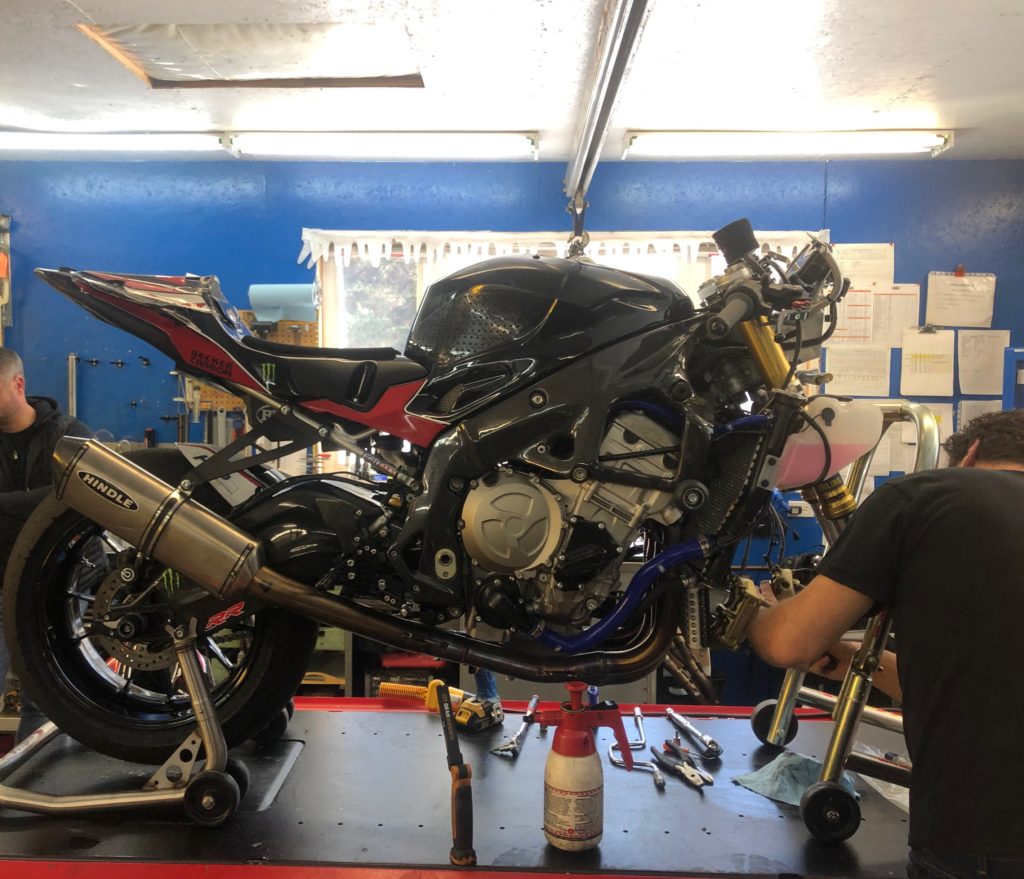Tech Question & Answer

Hello John, in previous race prep article you wrote, you mentioned that machining the head on a four stroke engine doesn’t tighten the squish….. – Billy Rae
Thank you Billy Rae for writing in. Let me expand a bit. A two stroke piston top is perfectly smooth and of course, an almost perfect circle. Its top shape can be flat or domed slightly depending on the design of that particular engine builder. The head that is bolted on top will typically have one centrally located spark plug in that head, but the head combustion area is round as well, meaning that if you turned the head up side down, it would form a perfect circle to match the piston. The head gasket as well has a perfectly round centre section to go between the two.
A four stoke cylinder is perfectly round as well, usually complicated a bit by 3 or 4 of them cast together, but this doesn’t affect our discussion at all. A modern 4 stroke piston top however looks very different from its 2 stroke cousin. Whereas the 2 stroke piston has a perfectly smooth uniform domed or flat surface, the 4 stroke piston has a very messy, convoluted top surface. Picture a big smooth domed piston, and then 4 big end mill surface cutters come down and cut four flat circles onto the piston. In the case of a 600cc street bike engine, two flats are the size of twoonies, and two are slightly smaller, approximately the size of loonies. It isn’t hard to imagine, when glancing from the piston to the head, that these four recesses into the round piston are to give us clearance for the two larger intake valves, and the two slightly smaller exhaust valves. These ‘valve pockets’ in the piston top as we call them are necessary because all 4 valves stay open slightly between the engine’s exhaust stroke and the intake stroke during a period you may have heard called overlap. These pockets give these valves room to not only avoid getting hit while the piston rises to and falls away from top dead centre, but it also gives them room to continue to breathe during this period as well. On the next stroke in a four stroke engine, the compression stroke, the valves are all shut tight and this extra clearance and odd piston top shape isn’t needed, but at 14,000 rpm, there isn’t enough time to get in there and change the piston design for every other rotation of the crankshaft, even if you were super fast….
Now, if you glance over at the 4 stroke head upside down beside you on the work bench, you do not see a round area to match the round cylinder or round piston. What you see are 4 valve heads clustered around a central spark plug hole surrounded by the flat cylinder head surface.
Now, lets talk about squish in a bit more detail. Back to our old simple 2 stroke engine with the smooth piston top and smooth matching cylinder head, we can see that there is an area around the outer perimeter of the cylinder head that closely matches the slope of the piston. This is the area where we measure our squish. It is the zone where the piston gets closest to the head. Then, the centre of the head slopes or domes up to give us room for our pocket of fuel and air to get ignited by the spark plug. This is the actual combustion area. Not much combustion happens out in the squish area, so engine builders usually aim to reduce this clearance down to a safe minimum. A nice tight squish area helps to squirt the fuel mixture into the centre of the combustion area, aiding in maintaining turbulence for a good burn. On our more convoluted 4 stroke piston, the area around and to the outside of the valve pockets is our squish area, and it is flat, perfectly parallel to the cylinder head. This is the key sentence to answering your question. The cylinder head surface doesn’t get any closer to the piston when you machine material off the cylinder head surface. This distance is fixed by the thickness of the head gasket. The valves and the spark plug come down with every cut off the head and that clearance gets tightened, but the squish doesn’t tighten. I hope that my description, along with these photos, helps to answer your question Billy Rae.
Another question came in from Wayne Kerr in Vancouver: Wayne asks:
“My friend tells me when doing an oil change to run the engine for a bit after the drain plug is out to continue to pump out all the dirty oil, but you mentioned how you prime your race engines… Is this the same thing?”
Oh my god no! You should never, ever, run your engine without oil. Actually it would be ok for about 1 second, but then the oil pump would run dry and you would lose oil pressure to your crankshaft main and rod bearings. These bearings, unlike a 2 stroke are not roller ball bearings, they are thin aluminum plain bearings. They need oil pressure to form a protective barrier to absorb the severe downward impact between the piston rod and the crankshaft. This protective barrier also allows the crankshaft to spin freely in the crank case, ‘floating’ on this thin film of oil.
During an oil change, the oil trapped in the intake strainer, which is a tube with a coarse screen on it under the oil pump that goes down to the bottom of your oil pan, gets drained out during an oil change. Then, when fresh oil is poured back into the pan, this intake strainer, much like a tall empty glass held a few millimetres from the bottom of your sink as you fill the sink with water, remains full of air. This is the reason why you can fill your oil to the “full” mark, then you always need to add almost another half litre after starting it. What you maybe don’t realize is that the engine ran without any oil pressure for maybe 5 to 10 seconds before it primed and got fresh oil into the pump. It needed to suck that air out of your upside down glass in your sink. Way more damage was done to your engine right then than the next long trip you went on for sure! After filling the engine with fresh oil, we crank the engine over without letting it start for 20 or 30 seconds to ensure it has re-primed the pump before we start it. This can be accomplished by disconnecting the fuel pump or the crank position sensor lead into the wiring harness.
